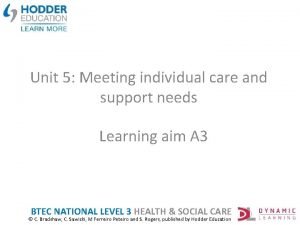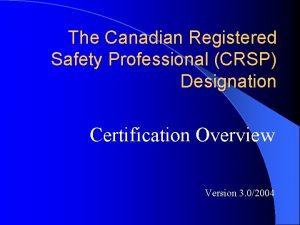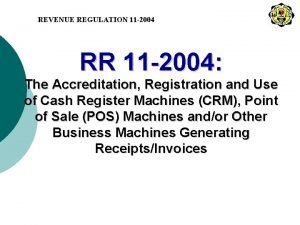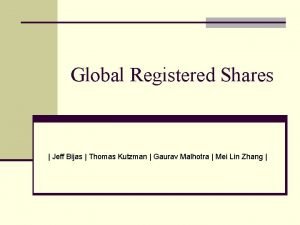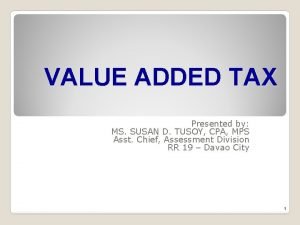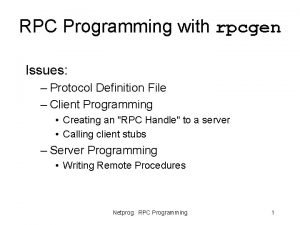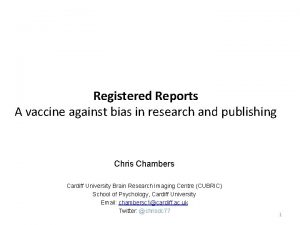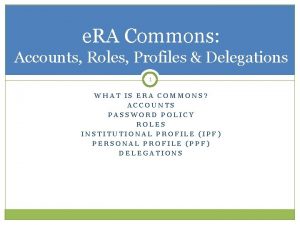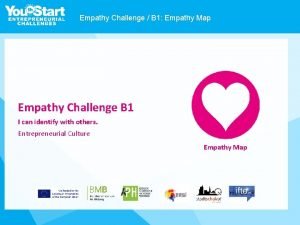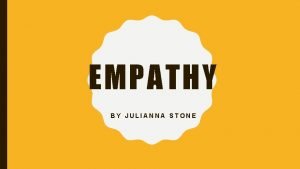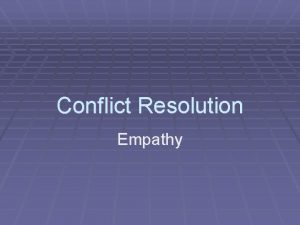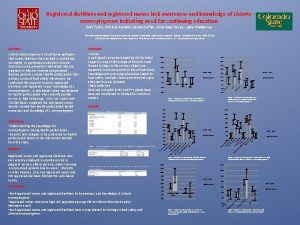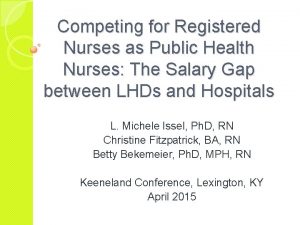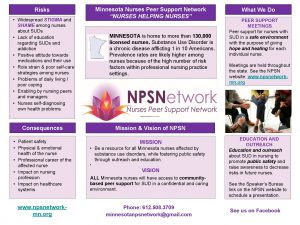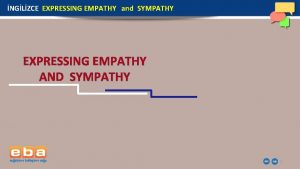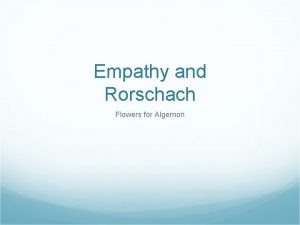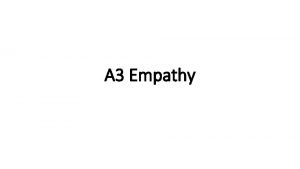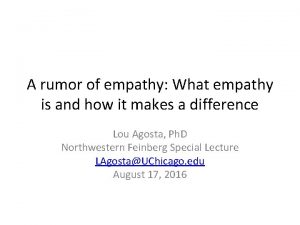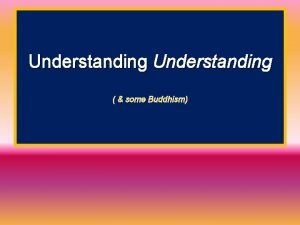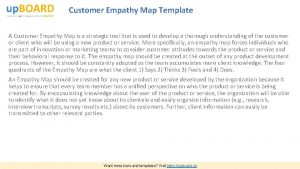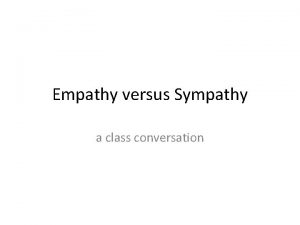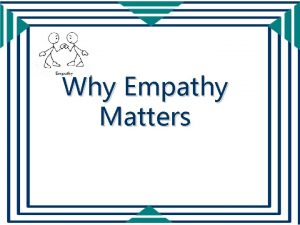Social Empathy and Associated Factors Among Registered Nurses


































- Slides: 34

Social Empathy and Associated Factors Among Registered Nurses Gudrun Klim, Ph. D, MA, RN Nurse Bioethicist PROVIDENCE HEALTH AND SERVICES EASTERN WASHINGTON AND MONTANA

Credits: Dissertation Committee LLU: Elizabeth Johnston Taylor, Ph. D, RN, FAAN Lisa Roberts, Dr. PH, MSN, RN, FNP-BC, CHES, FAAN Kendal Boyd, Ph. D, MA Statistical Support LLU: Dr. Wendy Shih, Dr. PH, LLU School of Public Health + team Providence Health & Services Eastern Washington and Montana: Tiffanie Rampley, Ph. D, MA, BSN, RN, CCRN-K, Nursing Research Coordinator, Don Craton, REDCap, Volunteer Administrator

Empathy • Universal human trait • Comprised of a cognitive and emotional components • Empathy is the social glue that allows humans to become global citizens. • Follows specific neurological pathways in the brain • Cognitive empathy is a trainable skill Photo: https: //www. theguardian. com/globaldevelopment/2015/jan/19/sustainable-development-goals-united-nations

Neurological Pathways of Empathy f. MRI scans showing brain activity in pain and empathy responses. (Tania Singer / University College London, https: //charterforcompassion. org/discovering-empathy/dr-taniasinger-and-the-neuroscience-of-empathy)

Ethical Imperative • Empathic behaviors can occur even if a person or situation generates little or no affective empathic response, because cognitive empathy is sufficient to trigger an empathic response. • Because engaging in cognitive empathy is a choice, it also becomes a moral endeavor.

Social Empathy Social empathy is a newly developed construct within the realm of social work. https: //hevria. com/davidkarpel/the-impotence-ofempathy-in-the-kitchen/ It is “the ability to more deeply understand people by perceiving or experiencing their life situations and as a result gain insight into structural inequalities and disparities” (Segal, 2011, p. 266)

Social Empathy First model by Segal et al. , detailing how social empathy is related to various contributing and outcome factors. (Segal, Wagaman & Gerdes, 2012, p. 544)

Social Empathy • Affective response (AR), • Self-other awareness (SOA • Cognitive (COG) • Macro-perspective taking (MPT)

Upstream Causes: Social Determinants of Health: • Education • Economic stability • Social and community context • Health and healthcare • Neighborhood or built area where one lives • The Social Determinants of Health impact morbidity, mortality, and quality of life. (Healthy People 2020)

Social Determinants of Health • “Bodies are worn out by the same forces as the rags that cover them” (A worker’s speech to a doctor, Bertolt Brecht, 1898– 1956) • “. . . health is more related to social, economic and political health determinants than to a biomedical dominated, individually focused ‘healthcare’ system” (Falk. Rafael, 2005, p. 212) Two girls wash clothes in the street Photograph: Horace Warner/The Religious Society of Friends in Britain Facebook. Twitter. Pinterest

“Your zip code is a better predictor of your health than your genetic code. ” Melody Goldman Keynote Address at Dana – Farber Cancer Institute Harvard School of Public Health (HSPH) July 24, 2014 (https: //www. hsph. harvard. edu/news/features/zip-code-better-predictor-of-health-than-genetic-code/)

“When I feed the poor, they call me a saint; when I ask why they are poor, they call me a communist” • Brazilian Catholic Archbishop Hélder Câmara, (Daley, Bell, Banout, & Currie, 2012, p. 471)

The Effects of Empathy on Wellness • Out of 891 patients, those who had a > empathic-scoring physician were sig. more likely to have optimal diabetes control than patients with < empathic-scoring physicians (Hojat et al. , 2011). Empathy Wellness • The severity and duration of cold symptoms were lessened when patients perceived their physicians as caring. Their blood levels of IL-8 and neutrophils < sig (Rakel et al. , 2011).

Purpose • The aim of this study was to measure social empathy among Registered Nurses (RN) and what demographic, personal, and workrelated factors are associated with social empathy.

What Factors Are Associated With Social Empathy? Work-related factors: Burnout Satisfaction with work environment Years employed as a RN Level of education in nursing Current nursing position Hours worked per week Current work setting Personal factors: Advocacy Self-compassion Spiritual experience/religiosity Demographic: Age Gender Ethnicity Having a history of receiving government subsidies

Design and Methods A quantitative, cross-sectional, observational study approach was used to generate descriptive and correlational evidence. Setting and Sample: 3, 663 Registered Nurses (RNs) working in 2018 for a large non-profit healthcare system in Eastern Washington and Montana. 614 RNs responded (17% response rate) Recruitment and Procedure: • Email invitation via the organizations’ e-mail alert system. • Secure individual link to access the survey on the online survey platform REDCap.

Measures Single survey tool with 60 total questions Demographic inquiry: Questions 1 – 10 • Interpersonal and Social Empathy Index (ISEI) (Segal, Cimin Gerdes, Harmon, Wagaman , 2013). • MPT – ISEI (Macro – Perspective Taking) • COG – ISEI (Cognitive – Empathy) • SOA – ISEI (Self – Other Awareness) • AR – ISEI (Affective – Response) • Social Issues Advocacy Scale (SIAS) (Nilsson, Marszalek, Linnemeyer, Bahner, & Hanson Misialek, 2011) • Self–Compassion Scale – Short Form (SCS–SF) (Neff, 2003) • Single–Burnout Measure (West, Dyrbye, Satele, Sloan, & Shanafelt, 2012) • Brief Trust/Mistrust in God Scale (Hafizia, Rosmarin, & Koenig, 2014)

Statistical Tests Performed • Measures of Central Tendency • ANOVAs • Pearson Correlation • Multilinear Regression

How Socially Empathic Are Registered Nurses Employed in a Large Healthcare System? Descriptive Statistics Related to the ISEI Scores * Percent of Maximum points possible

ANOVA: Feeling Supported in Providing Compassionate Care Showed Significant Results for Total ISEI

ANOVA: Having Received Government Subsidies in the Past (or Not) Was significantly associated With Total ISEI Note. *p = 0. 02

Pearson Correlation

Regression Analysis for the Personal Variables and Total ISEI Model B*

Regression Analysis for the Work-Related Variables and Total ISEI Model B* *Unstandardized estimate

Regression Analysis for the Demographic Variables Total ISEI Model B* *Unstandardized estimate

Multiple Linear Regression Analysis: Demographic Variables + Personal Variables + Work-Related Variables Explaining Social Empathy R squared = 0. 288 Outcome: ISEI Total B* SE t p (Intercept) 45. 46 4. 007 11. 35 p<0. 001 Age -0. 10 0. 05 -2. 20 0. 03 Advocacy Scale 0. 36 0. 03 10. 92 p<0. 001 SCS-SF 0. 26 0. 07 3. 67 p<0. 001 Burnout -0. 30 0. 11 -2. 74 0. 006 Working Hours: Over Time vs Part Time -2. 57 1. 18 -2. 18 0. 03 Nursing Degrees: Baccalaureate vs. Associate Degree -1. 44 0. 68 -2. 13 0. 03 Graduate Degree vs. Associate Degree -3. 45 1. 46 -2. 36 0. 02 Current Nursing Position: Management vs. Staff Nurse 3. 76 1. 29 2. 91 0. 004 *Unstandardized estimate

Implications and Discussion • This study is the first to our knowledge to measure social empathy using the ISEI among nurses. • The data provide a benchmark for social empathy beyond its original field of social work. • Although some factors found to explain social empathy are unchangeable (e. g. , age, gender), others are. • Intervention-amenable contributors are burnout, self-compassion, and interest in advocating for social issues. • These findings support that social empathy can be nurtured.

Social Empathy = Conscious Choice Being considerate and empathic when one is disagreeing with another person is not easy; indeed “it takes will”. (Shushok, 2015, p. 2)

You are never too young …… Photo: http: //www. listentoyourbaby. com/roots-of-morality. html

or too old ……. . to give and receive empathy Photo: https: //www. homecarepulse. com/articles/train-and-retain-caregivers-with-a-caregivermentor-program/

References Brecht, B. A worker’s speech to a doctor. Retrieved from: https: //www. medhumchat. com/discussionguides/2019/6/12/bertolt-brecht-a- workers-speech -to-a-doctor Daley, P. , Bell, R. J. , Banout, A. , & Currie, J. (2012). Leaders in faith- based organizing networks. International Journal of Public Theology, 6, 467 – 478. Falk-Rafael, (2005). Speaking truth to power: Nursing's legacy and moral imperative. Advances in Nursing Science, 28(3), 212 – 223. Fowler, M. , D. , Reimer-Kirkham, S. , Sawatzky, R. , & Taylor, E. J. (Eds. ). (2012). Religion, religious ethics, and nursing. New York: Springer. Hafizia, S. , Rosmarin, D. H. , & Koenig, H. G. (2014). Brief trust/Mistrust in God scale: Psychometric properties of the Farsi version in Muslims. Mental Health, Religion & Culture, 17(4), 415 – 420. Healthy People 2020. [Internet]. Washington, DC: U. S. Department of Health and Human Services, Office of Disease Prevention and Health Promotion [Retrieved June 12, 2019]. Available from: https: //www. healthypeople. gov/2020/topics objectives/topic/social-determinants-of-health

References (con. ) Hojat, M. , Louis, D. Z. , Markham, F. W. , Wender, R. , Rabinowitz, C. , & Gonnella, J. S. (2011). Physicians’ empathy and clinical outcomes for diabetic patients. Academic Medicine, 86(3), 359 – 364. Manchanda, R. , (2013). The upstream doctors: Medical innovators track sickness to its source. New York, NY: TED Conference, LLC. Neff, K. D. (2003). The development and validation of a scale to measure self-compassion. Self and Identity, 2, 223 – 250. Nickols, S. Y. & Nielsen, R. B. (2011). "So many people are struggling": Developing social empathy through a poverty simulation. Journal of Poverty, 15, 22 – 42. Nilsson, J. E. , Marszalek, J. M. , Linnemeyer, R. M. , Bahner, A. D. , & Hanson Misialek, L. (2011). Development and assessment of the Social Issues Advocacy Scale. Educational and Psychological Measurement, 71(1), 258 – 275. Rakel, D. , Barrett, B. , Zhang, Z. , Hoeft, T. , Chewning, B. , Marchand, L. , & Scheder, J. (2011). Perception of empathy in therapeutic encounter: Effects on the common cold. Patient Education and Counseling, 85(3), 390 – 397.

References (con. ) Riess, H. (2017). The science of empathy. Journal of Patient Experience, 4(2) 74 – 77. Segal, E. A. (2011). Social empathy: A model built on empathy, contextual understanding, and social responsibility that promotes social justice. Journal of Social Service Research, 37, 266 – 277. Segal, E. A. , Cimino, A. N. , Gerdes, K. E. , Harmon, J. K. , & Wagaman, M. A. (2013). A confirmatory factor analysis of the Interpersonal and Social Empathy Index. Journal of the Society for Social Work and Research, 4(3), 131 – 153. Segal, E. A. , Wagaman, M. A. , & Gerdes, K. E. (2012). Developing the Social Empathy Index: An explanatory factor analysis. Advances in Social Work, 13(3), 541 – 560. Shushok, F. , Jr. (2015). Editor’s note: On teaching empathy. About Campus, (July – August), 2. Retrieved from http: //onlinelibrary. wiley. com/store/10. 1002/abc. 21191/asset/abc 21191. pdf? v =1&t=j 2 t 8 evqn&s=a 4 c 7 fd 6 f 2256 eaf 22 d 212 f 0 d 8 e 544996 ecf 67 d 9 c

References (con. ) Singer, T. (2006). The empathic brain: How, when and why? TRENDS in Cognitive Sciences, 10(10), 435 – 441. Singer, T. (2015, January, Davos). The neuroscience of compassion. [Video file]. Retrieved from https: //www. youtube. com/watch? v=n-h. KS 4 ruc. TY Singer, T. & Lamm, C. (2009). The social neuroscience of empathy. Annals of the New York Academy of Sciences, 1156(1), 81 – 96. Singer, T. , Seymour, B. , O’Doherty, J. , Kaube, H. , Dolan, R. J. , & Frith, C. D. (2004). Empathy for pain involves the affective but not sensory components of pain. Science, 303(5661), 1157 – 1162. West, C. P. , Dyrbye, L. N. , Satele, D. V. , Sloan, J. A. , & Shanafelt, T. D. (2012). Concurrent validity of singleitem measures of emotional exhaustion and depersonalization in burnout assessment. Journal of General Internal Medicine, 27(11), 1445 – 1452. Yang, N. , Xiao, H. , Cao, Y. , et al. (2018). Influence of oncology nurses’ empathy on lung cancer patients’ cellular immunity. Psychol Res & Behav Manage, 11, 279 -287.
 How do the 6cs prevent discrimination
How do the 6cs prevent discrimination Martin hoffman empathy theory health and social care
Martin hoffman empathy theory health and social care Preparatory exploring social work
Preparatory exploring social work Canadian safety professional certification
Canadian safety professional certification Rr 11-2005
Rr 11-2005 Registered automotive workshop scheme
Registered automotive workshop scheme Pcatp
Pcatp Appointment of registered valuer under companies act, 2013
Appointment of registered valuer under companies act, 2013 Registered provider
Registered provider Registered training organisation list
Registered training organisation list Electronic registered delivery service
Electronic registered delivery service Nhtsa registered importers
Nhtsa registered importers Global registered share
Global registered share Ubc nursing program
Ubc nursing program Registered nurse requirements california
Registered nurse requirements california Liabilities of registered trade union
Liabilities of registered trade union Lone star north harris nursing
Lone star north harris nursing Rdsp catch up calculator
Rdsp catch up calculator Ordnance factory registration
Ordnance factory registration Subsidiary sales journal for vat registered taxpayer
Subsidiary sales journal for vat registered taxpayer College of registered psychotherapists of ontario
College of registered psychotherapists of ontario Ulookup
Ulookup Registered report
Registered report Providers registered with mmcc
Providers registered with mmcc Barakatun nisak
Barakatun nisak Commons registered organizations
Commons registered organizations Scope of registered valuer
Scope of registered valuer Majoritarianism
Majoritarianism Social thinking and social influence in psychology
Social thinking and social influence in psychology Social thinking social influence social relations
Social thinking social influence social relations Biotic and abiotic drawing
Biotic and abiotic drawing Abiotic factors and biotic factors
Abiotic factors and biotic factors Aboitic environment
Aboitic environment What is the greatest common factor of 16 and 48
What is the greatest common factor of 16 and 48 7-1 factors and greatest common factors
7-1 factors and greatest common factors

